Effortless No-Knead Chocolate Tahini Babka: Your Guide to Soft, Gooey Swirls
Prepare to fall in love with this incredible chocolate tahini babka. It’s an absolute masterpiece of texture and flavor: unbelievably soft, exceptionally rich, and brimming with irresistible, gooey chocolate-sesame swirls. What makes this recipe truly special is its enriched dough, which is surprisingly simple to prepare – no arduous kneading required! Just a quick mix, a gentle rise, and then you’re ready to fill, shape, and bake. The star ingredient, nutty tahini, doesn’t just add a unique depth; it brilliantly enhances and elevates the rich, luscious, chocolate goodness, creating a flavor profile that’s both comforting and sophisticated. This babka isn’t just a treat; it’s an experience, promising a perfect balance of sweetness and a hint of earthy sesame in every single bite.
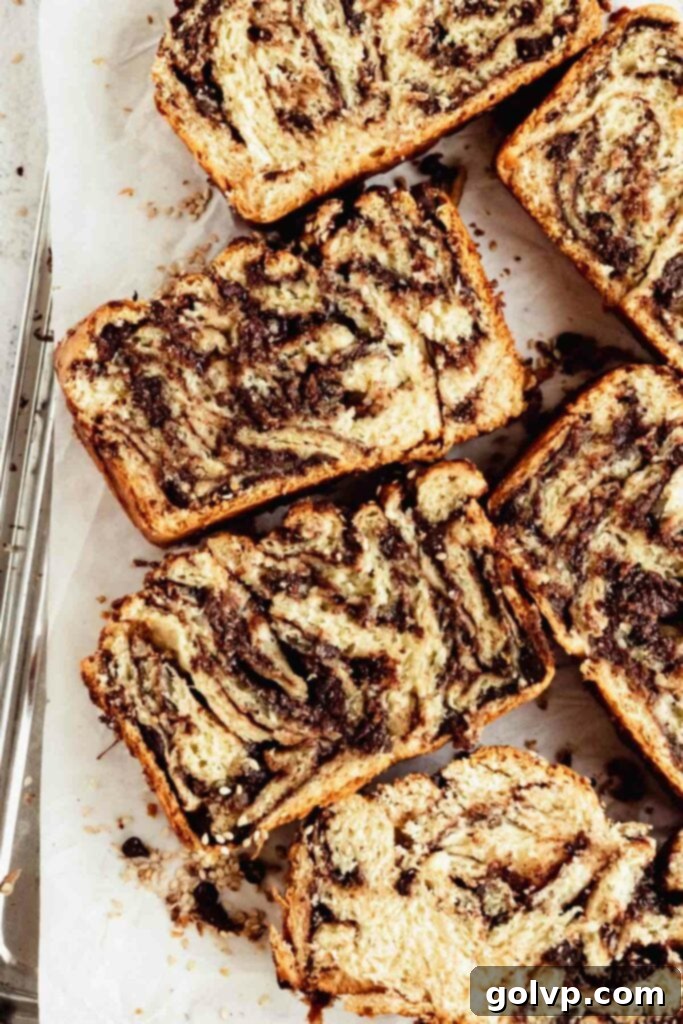
Purchasing the items in this post supports this blog, at no additional cost to you. As an Affiliate Product marketer and Amazon Associate, I earn from qualifying purchases.
Why You’ll Absolutely Adore This Chocolate Tahini Babka Recipe:
- Unrivaled Softness & Fluffiness: Every single time, this babka emerges from the oven wonderfully soft, tender, and incredibly fluffy. The enriched dough, packed with butter, creates a truly luxurious crumb that melts in your mouth, making it far from dry or dense. It’s the kind of texture you dream of in a homemade pastry!
- Effortless, No-Knead Dough: Say goodbye to strenuous kneading or needing an expensive stand mixer! This recipe comes together in about 5 minutes of active prep time, requiring only a bowl and a spoon. The simplicity of this no-knead method makes baking a gorgeous babka accessible to everyone, from novice bakers to seasoned pros looking for an easier approach.
- Irresistible Gooey Chocolate Swirls: The heart of this babka lies in its decadent chocolate filling. When baked, it transforms into luscious, warm, gooey swirls that are utterly addictive. Each slice reveals layers of rich chocolate that perfectly complement the soft bread, promising a truly indulgent experience.
- Tahini: The Secret Flavor Amplifier: The addition of tahini (sesame paste) is a game-changer. It doesn’t just add a unique, slightly nutty and earthy undertone; it profoundly amplifies the richness and depth of the chocolate. This unexpected pairing creates a sophisticated, well-balanced flavor that elevates the babka beyond a simple chocolate bread.
- Extra Gooeyness with Chocolate Chips: For an added burst of chocolatey goodness and an even more luxurious, gooey texture, we fold in extra chocolate chips into the filling. These melt beautifully during baking, ensuring that every bite is packed with melted chocolate pockets that make this babka truly irresistible.
[feast_advanced_jump_to]
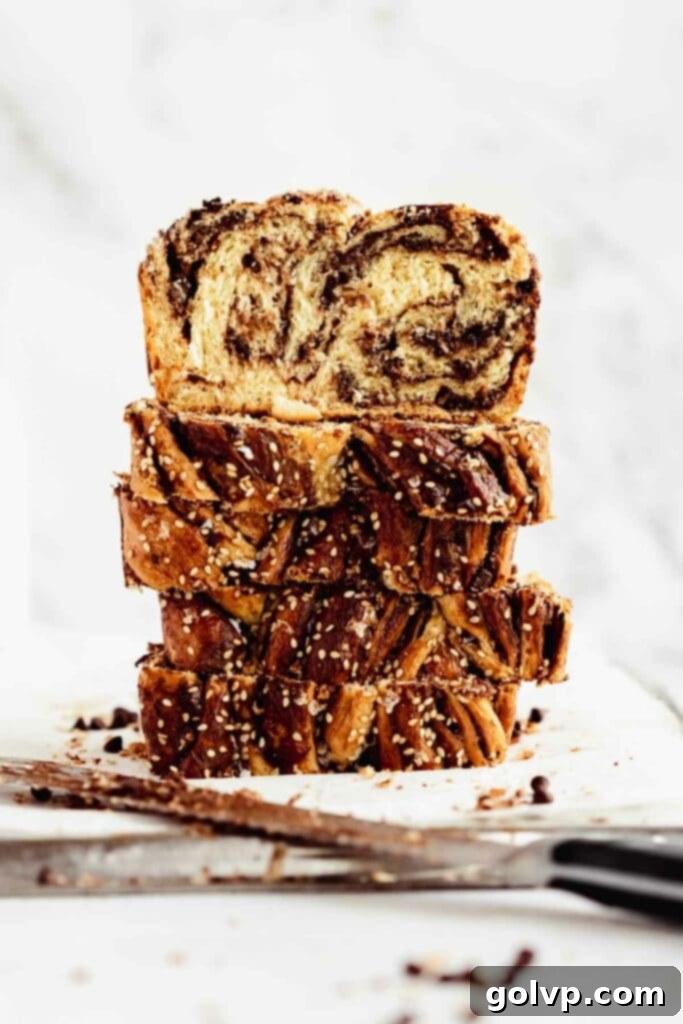
Mastering the BEST No-Knead Babka Dough
This recipe truly champions the “no-knead” philosophy, delivering a chocolate tahini babka that’s incredibly tender without the usual effort. The beauty of this dough lies in its simplicity and accessibility. You won’t need any specialized equipment, like an electric stand mixer, to achieve a beautifully enriched and elastic dough. All it takes is a large bowl and a sturdy spoon to bring it all together, making it perfect for bakers of all skill levels.
The process is incredibly straightforward: first, you’ll ensure your yeast is active and lively, a crucial step for any successful bake. Then, you simply combine all the dough ingredients. Don’t be alarmed by its initial very wet and sticky consistency; this is exactly how an enriched no-knead dough should look. This high hydration contributes to the babka’s ultimate softness and moisture. After a hands-off rise, the dough develops its structure and becomes much easier to handle. From there, it’s just a matter of gently punching it down, rolling it out, spreading the sumptuous filling, rolling it into a log, cutting it to reveal the stunning layers, twisting it into its iconic babka shape, and finally, baking it to golden perfection. This versatile dough is so reliable and delicious, I even use it for other treats like these gooey funfetti cinnamon rolls, proving its adaptability and consistent success.
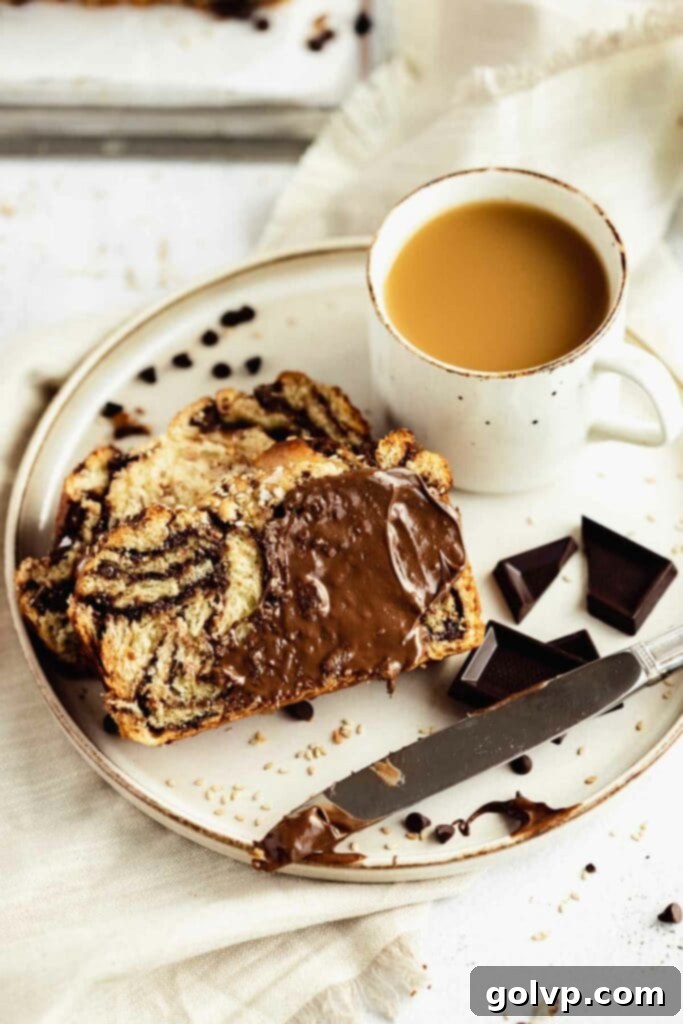
Crafting the Perfect Chocolate Tahini Filling
The luscious filling is what truly sets this chocolate tahini babka apart, creating those beautiful, gooey swirls that are the hallmark of a great babka. While the idea of a homemade filling might sound intimidating, it’s surprisingly simple and incredibly rewarding. You start by combining all the filling ingredients—tahini, butter, dark chocolate, cocoa powder, powdered sugar, vanilla, and a pinch of salt—in a saucepan. Gently heat them over low heat, stirring continuously, until everything melts together into a smooth, cohesive, and wonderfully fragrant paste. This slow melting process ensures a perfectly emulsified filling that spreads beautifully and bakes into a melt-in-your-mouth texture.
Before rolling up the babka, we take the indulgence a step further by sprinkling in mini chocolate chips. These tiny morsels melt into delicious pockets of chocolate within the babka, enhancing its gooeyness and adding another layer of texture. If you’re pressed for time or simply prefer a shortcut, you can absolutely opt for a high-quality store-bought chocolate sesame butter. I’ve experimented with several brands, and they’ve all yielded fantastic results, proving that convenience doesn’t have to mean compromising on flavor. The key is to choose a filling that offers a good balance of rich chocolate and nutty tahini to achieve that signature taste.
Unveiling the Charm: What Exactly is a Babka?
If you’re new to the world of babka, imagine a richer, more elaborate cousin to the classic cinnamon roll. Originating from Eastern European Jewish communities, babka is a sweet, braided bread that has captured hearts with its stunning swirled appearance and delectable fillings. Its name, derived from the Polish word “babcia” or “babka,” meaning “grandmother” or “little grandmother,” often refers to the shape of the bread, reminiscent of a pleated skirt or a small, elderly woman. This traditional brioche-like or challah-style dough is enriched with butter and eggs, giving it an unparalleled softness and tender crumb.
The magic of babka lies in its distinctive preparation method. The rich dough is meticulously rolled out into a large rectangle, then generously spread with a flavorful filling – traditionally chocolate, cinnamon, or even fruit. After being rolled into a tight log, it’s cut in half lengthwise, exposing all the beautiful layers of dough and filling. These two halves are then artfully twisted or braided together, forming a loaf that, when baked, boasts a mesmerizing marble-like pattern. This twisting technique not only creates a visually appealing pastry but also ensures that every slice delivers a delightful explosion of flavor and texture, from the soft, buttery bread to the gooey, sweet filling. It’s truly a celebration of baking, offering a wonderful combination of artistry and taste.
Essential Tips for a Flawless No-Knead Babka
- Measure Flour with Precision: Achieving the perfect babka texture starts with accurate flour measurement. For the most consistent and best results, always use a digital kitchen scale to weigh your flour. If a scale isn’t available, employ the “spoon and level” method: gently stir your flour in its container, then spoon it into your measuring cup, and level off the top with the flat edge of a knife without packing it down. This prevents adding too much flour, which can lead to a dry, dense babka.
- Never Skip Blooming the Yeast: This initial step is non-negotiable! Dissolving your yeast in warm water with a touch of sugar and letting it sit until a foamy layer forms on top is your guarantee that the yeast is active and alive. If your yeast doesn’t foam within 5-10 minutes, it’s likely inactive, and your dough won’t rise. It’s better to start with fresh yeast than waste all your ingredients on a flat babka.
- Use Genuinely Soft Butter: The butter incorporated into this enriched dough needs to be very soft, almost at the point of melting. This ensures it emulsifies properly with the other ingredients, creating a smooth, homogenous dough texture. I often warm my butter slightly in the microwave or a turned-off, still-warm oven until it’s pliable but not fully liquid.
- Embrace the Stickiness of the Dough: Don’t be alarmed if your dough feels quite sticky after mixing – this is entirely normal and expected for a high-hydration, no-knead dough. Avoid the temptation to add excessive amounts of extra flour, as this will make your babka tough. The dough will become less sticky and easier to handle after its initial rise, as the flour fully hydrates. When rolling, a lightly floured surface is sufficient to prevent sticking.
- Ensure a Warm Rising Environment: Yeast thrives in warmth. For a successful rise, place your covered dough in a consistently warm spot. My preferred method is to preheat my oven to 180°C (350°F) for just 3 minutes, then turn it off and let the dough rise inside. This creates an ideal, controlled environment. Be careful not to let the oven get too hot (it should not exceed 55°C / 130°F), as excessive heat can kill the yeast cells, preventing the dough from rising altogether. A warm spot is crucial for this enriched dough, as it tends to be more sluggish in cooler conditions.
- Avoid Overbaking for Ultimate Gooeyness: Overbaking is the enemy of a moist, gooey babka. Keep a close eye on your babka as it bakes. It should be beautifully golden brown on top and feel slightly hollow when gently tapped. If it bakes for too long, the delicate interior can dry out, and the chocolate filling might lose its signature gooey texture. Trust your senses and remove it from the oven promptly once done.
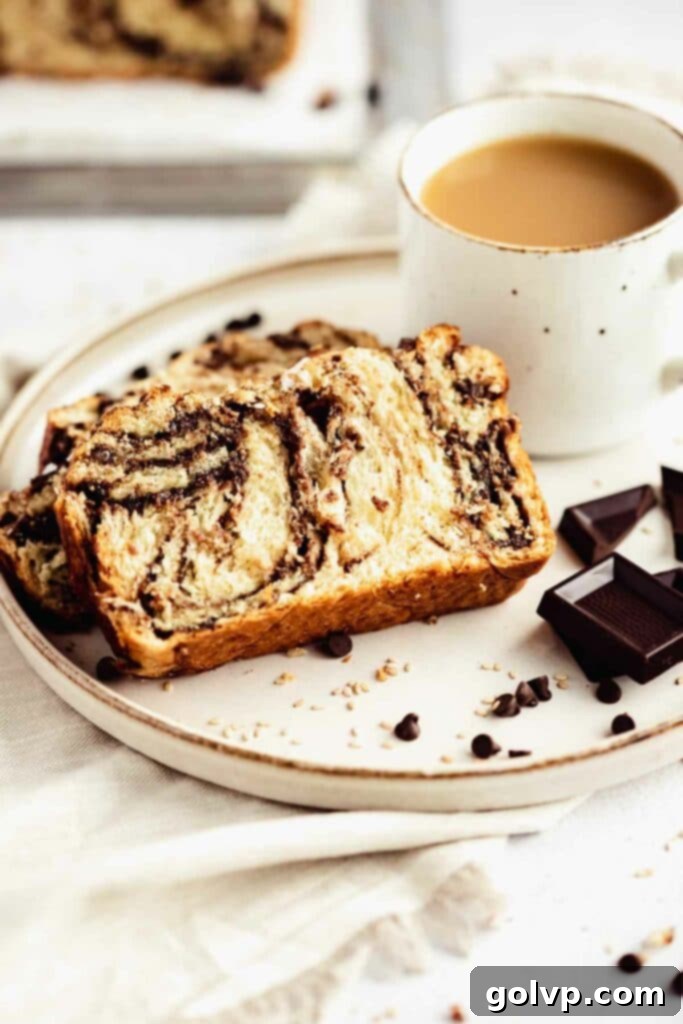
Understanding Your Key Ingredients for Babka Success
Success in baking often comes down to understanding the role of each ingredient. Here’s a closer look at the key components for your chocolate tahini babka:
Tahini: This essential ingredient is simply ground sesame seeds, forming a rich, nutty butter. It’s crucial to use pure tahini, not “tahini dressing,” which is a diluted product often containing other ingredients like lemon juice or garlic. Look for a smooth, pourable tahini made solely from sesame seeds (with perhaps some added oil for consistency). Its earthy flavor provides a wonderful counterpoint to the sweet chocolate, adding a sophisticated depth to the babka. A good quality tahini will significantly impact the final flavor profile.
Chocolate Chips: These are instrumental in achieving those incredible gooey chocolate swirls. I recommend a mix of mini chocolate chips and dark chocolate chunks for varied melt points and textures, contributing to a more dynamic filling. While dark chocolate offers a richer, more intense flavor that balances the sweetness, you can certainly use milk chocolate chips if you prefer a sweeter, creamier profile. Chopped high-quality chocolate bars also work wonderfully, providing a superior melt.
All-Purpose Flour: The foundation of our no-knead dough. Accuracy in measuring flour is paramount for the right dough consistency and a light, fluffy babka. I cannot stress enough the importance of using a kitchen scale for precise measurement (300g for 2 ½ cups is ideal). If you’re measuring by volume, always fluff the flour in its bag, then spoon it gently into your measuring cup, and level it off with a straight edge. Never scoop directly from the bag or pack the flour, as this can add significantly more flour than intended, leading to a dense and dry babka.
Active Dry Yeast: This yeast variety is my personal preference for its robust flavor development in enriched doughs, though instant dry yeast can be substituted in equal amounts. Active dry yeast requires blooming in warm water with sugar, which serves as a vital check to ensure it’s still alive and active before it’s mixed into the rest of your dough. This small step prevents potential baking disasters and guarantees a beautiful rise.
Unsalted Butter: Real, unsalted butter is non-negotiable for the best flavor and texture in this enriched dough and filling. It provides richness, tenderness, and contributes to the babka’s golden crust. Ensure your butter is very soft—almost melted—for both the dough and the filling. This makes it much easier to incorporate smoothly, resulting in a consistent dough and a silky filling without lumps or separation.
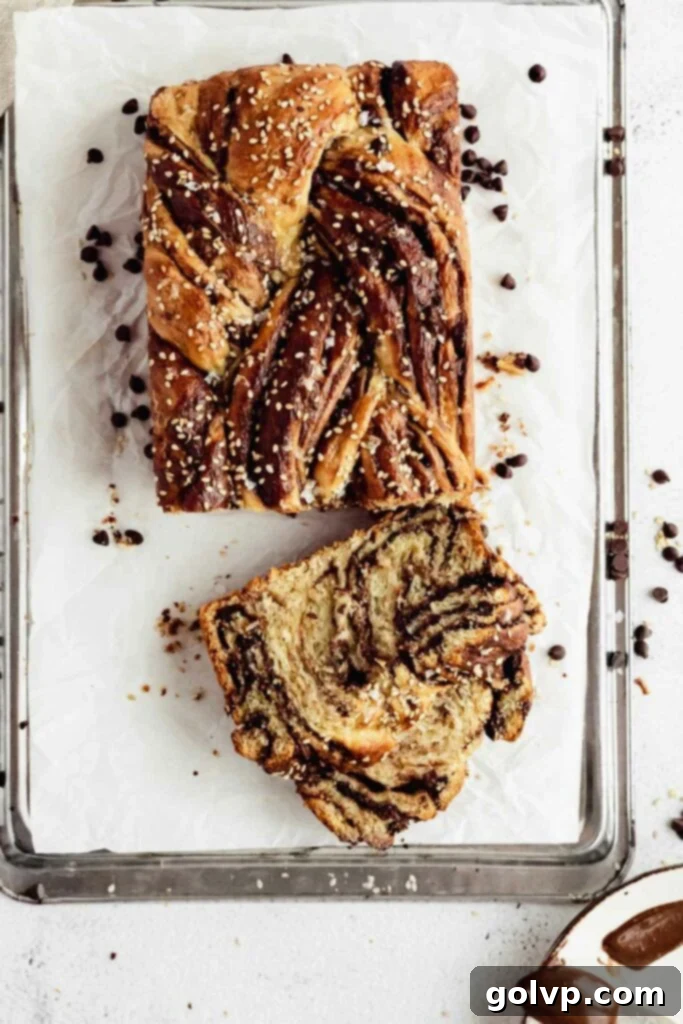
Simple Step-by-Step for the Decadent Filling
Crafting the perfect gooey filling for your babka is straightforward. Follow these easy steps to prepare the rich chocolate tahini mixture:
Step 1: In a small saucepan, combine all the filling ingredients, *except* for the mini chocolate chips. This includes your tahini, unsalted butter, chopped dark chocolate, natural cocoa powder, powdered sugar, pure vanilla extract, and sea salt. Place the saucepan over low heat and stir continuously with a spatula or whisk. Continue stirring until all the ingredients have fully melted and melded together into a wonderfully smooth, homogenous, and glossy mixture. Once smooth, remove the pan from the heat and allow the filling to cool completely to room temperature. This cooling step is important to prevent the warm filling from impacting your dough during assembly.
Easy Step-by-Step for the No-Knead Dough
This no-knead dough comes together with minimal effort, ensuring a soft and fluffy babka every time. Here’s how to do it:
Step 1: Begin by activating your yeast. In a small bowl or liquid measuring cup, combine the warm water and ½ teaspoon of granulated sugar. Sprinkle the active dry yeast over the top. Gently stir to dissolve the yeast and sugar. Let this mixture sit undisturbed for about 5 to 10 minutes, or until a visible layer of foam forms on the surface. This foam indicates that your yeast is active and ready to make your babka rise beautifully. If no foam appears, your yeast may be inactive, and it’s best to start with a fresh batch (see FAQs for more troubleshooting).
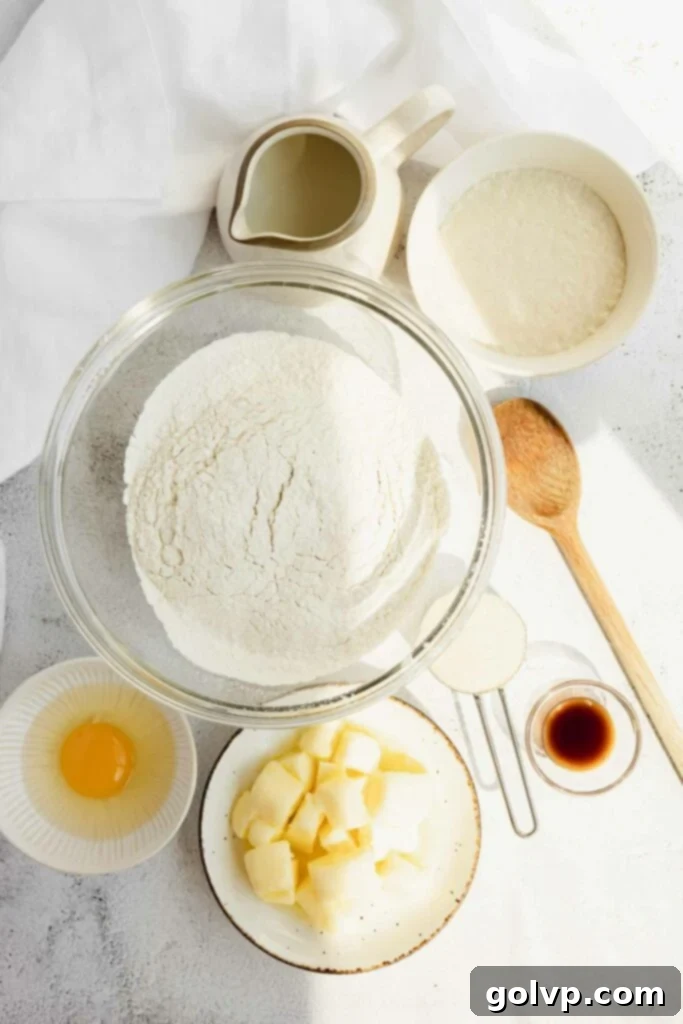
Step 2: In a large mixing bowl, sift your all-purpose flour. Create a deep well in the center of the flour. Pour the activated yeast mixture into this well, followed by the remaining dough ingredients: ¼ cup granulated sugar, ½ cup very soft (almost melted) unsalted butter, the large beaten egg, 1 teaspoon of pure vanilla extract, ⅓ cup warm milk, and ⅛ teaspoon of sea salt. Using a sturdy spoon or rubber spatula, mix all the ingredients together vigorously until a sticky, wet dough forms and all the flour is fully incorporated. It’s crucial that the dough is quite wet and sticky at this stage – it won’t be as firm as a traditional kneaded dough. If it appears excessively runny, more like a pancake batter, add a tiny bit more flour, one tablespoon at a time, until it resembles a thick, shaggy dough. Remember, it will become less sticky after rising.
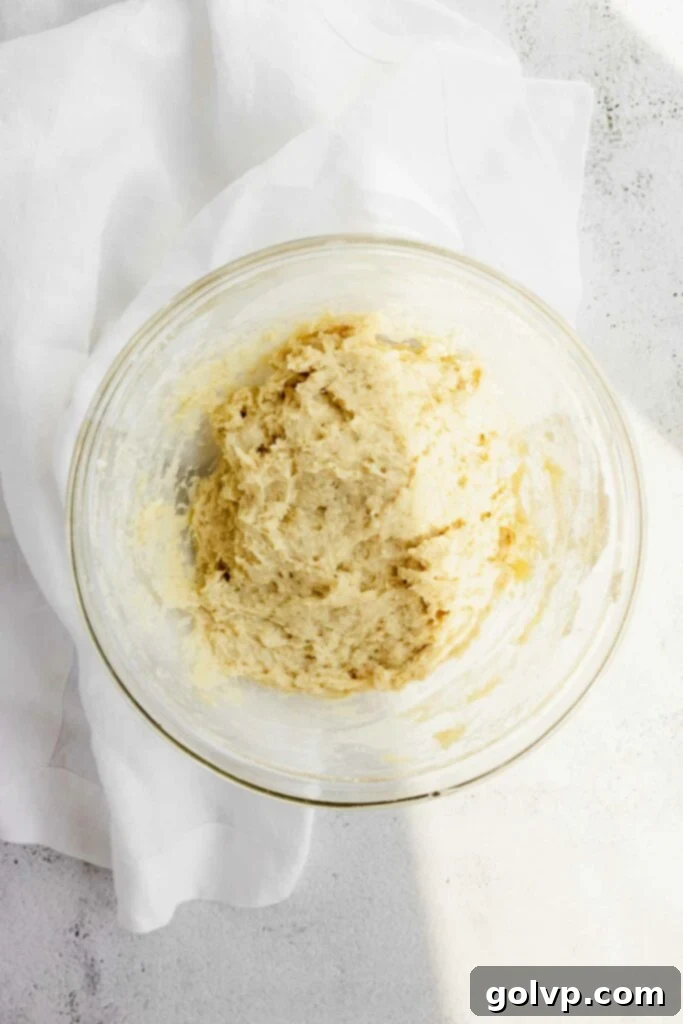
Step 3: Once your dough is mixed, cover the bowl with a clean, damp cloth or plastic wrap. Place it in a warm, draft-free area to rise. Allow it to rise for approximately 30 minutes, or until it has visibly doubled in size. Refer to the “Tips for Success” section for guidance on creating the ideal warm rising environment, as this enriched dough benefits greatly from consistent warmth.
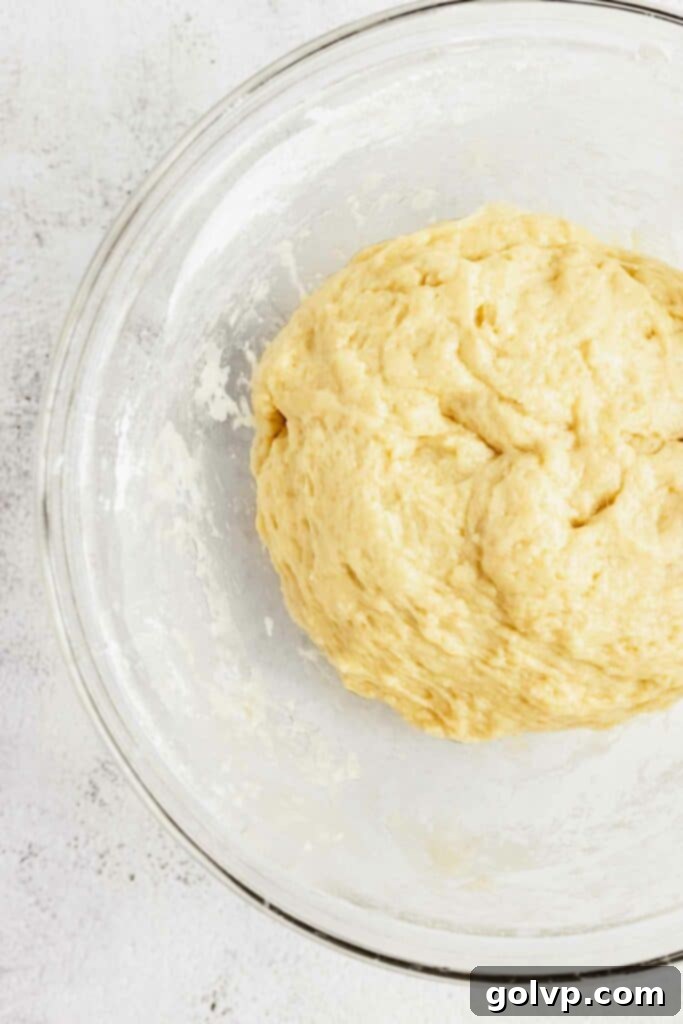
Step 4: While the dough is rising, prepare your 9×5 inch loaf pan. Line the pan with parchment paper, allowing an overhang on the two longer sides to create “handles.” These handles will make it incredibly easy to lift the finished babka out of the pan after baking, ensuring it keeps its beautiful shape.
Step 5: After the first rise, gently punch down the dough to release the air. Fold the dough a few times within the bowl to gently mix and redistribute the yeast. Lightly flour your work surface and your rolling pin. Transfer the dough onto the floured surface and roll it out into a large rectangle, approximately 18 inches by 23 inches in size. Ensure the dough is of even thickness. Now, evenly spread the cooled chocolate sesame filling all over the rolled-out dough, leaving a small border free on one of the long edges. Generously sprinkle the ¼ cup of mini chocolate chips over the filling. Carefully, starting from one of the short sides, tightly roll up the dough into a log.
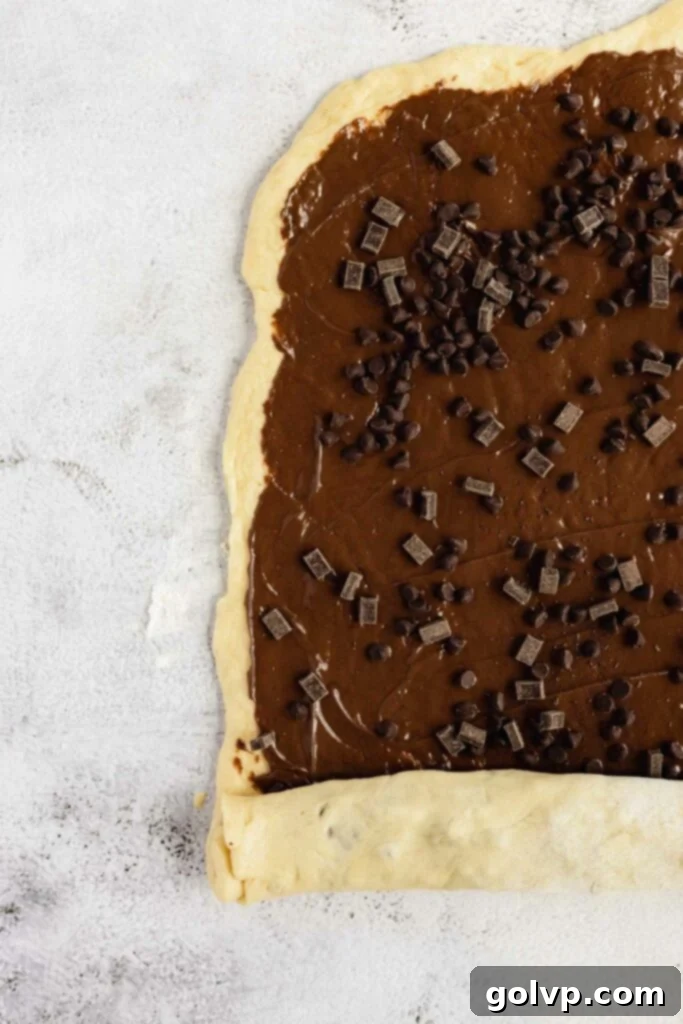
Step 6: Once you have your filled dough log, use a sharp knife or bench scraper to cut it in half crosswise, creating two shorter logs. Then, take each of these shorter logs and carefully cut them in half lengthwise. This will reveal all the beautiful layers of chocolate tahini filling. You will now have four strands. With the filling-side facing upwards, begin braiding the four strands together. You can either directly braid all four strands in an alternating pattern, or for a simpler yet equally stunning look, twist two strands together, then twist the other two strands together, and finally, twist these two larger twists together to form one mega twist. The key is to keep the filling visible as you twist to create those iconic babka swirls.
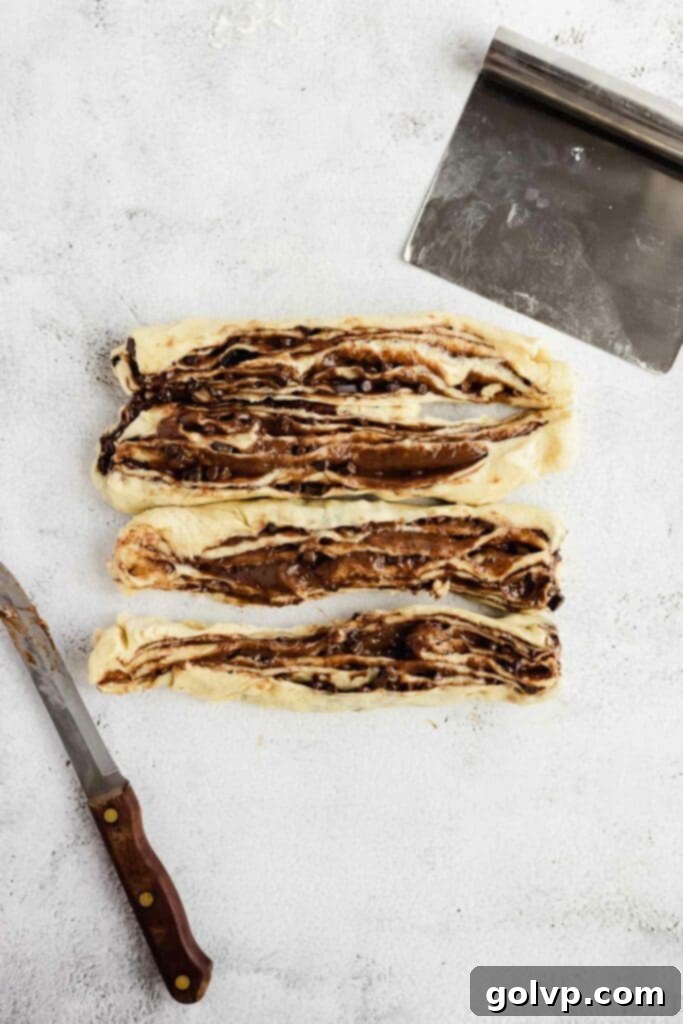
Step 7: Carefully lift your braided babka loaf and transfer it into the prepared parchment-lined loaf pan. Ensure it fits snugly but isn’t overly compressed. Cover the loaf pan lightly with a damp cloth or plastic wrap and place it back into a warm spot for its second rise. Let it rise for approximately 30 minutes, or until it has increased in size by about one-third. This final rise will make the babka even lighter and fluffier.
Step 8: While your babka is undergoing its second rise, prepare the egg wash. In a small bowl, whisk together one large egg and one tablespoon of milk until well combined. Once the babka has completed its second rise, gently brush this egg wash evenly over the entire surface of the loaf. This will give your babka a beautiful golden-brown, glossy crust. For an extra touch of flavor and visual appeal, sprinkle the top generously with sesame seeds and, if desired, a pinch of flaky sea salt to enhance the chocolate and tahini notes.
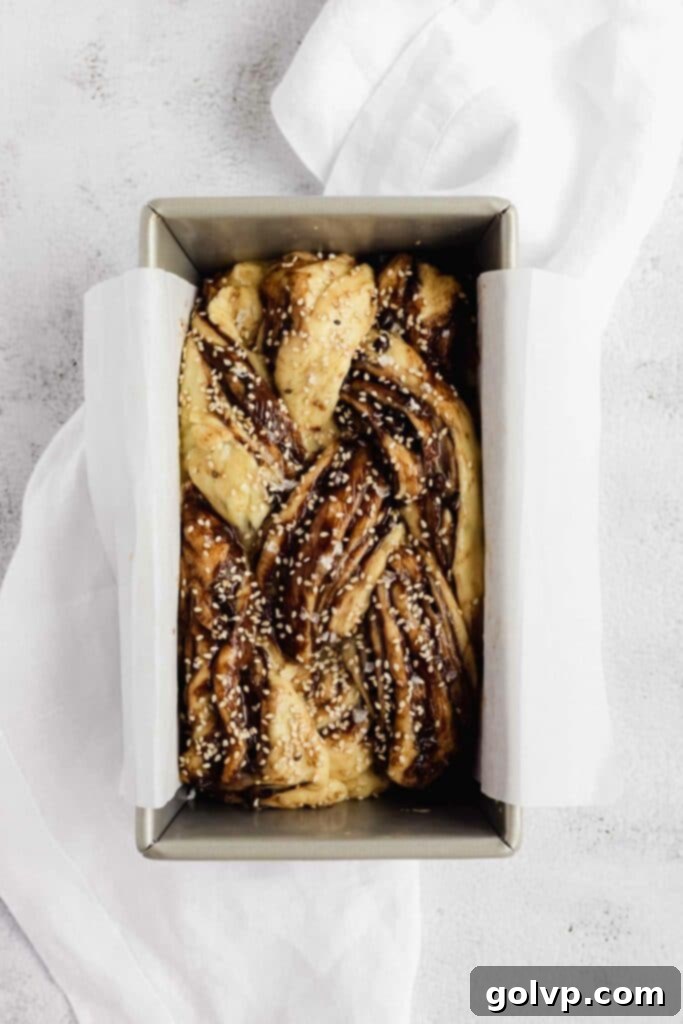
Step 9: Place the loaf pan with the babka into a cold oven, then immediately set the oven temperature to 180°C (350°F). Baking from a cold oven allows the babka to rise slightly more as the oven preheats. Bake for 30 to 40 minutes, or until the babka is beautifully golden brown on top and feels hollow when gently tapped on the bottom. To prevent over-browning, you can loosely tent the babka with foil during the last 10-15 minutes of baking if needed. Once baked, remove the pan from the oven and let the babka cool in the pan until it’s just warm. Then, using the parchment paper handles, carefully lift it out and transfer it to a wire rack to cool completely to room temperature. Resist the urge to cut into it while hot; cooling completely ensures the chocolate filling sets properly, yielding those perfect, gooey swirls.
Frequently Asked Questions About No-Knead Babka
The single most important factor for achieving a light, airy, and fluffy chocolate tahini babka is precise flour measurement. Flour is highly absorbent, and even a small excess can drastically change the dough’s consistency, leading to a heavy, dense final product. I highly recommend using a kitchen scale to weigh your flour for the most accurate results; it truly makes a world of difference. Even an inexpensive digital scale can elevate your baking significantly.
If you don’t have a scale, you can still measure flour accurately using the “spoon and level” method. First, fluff up the flour in its bag or container with a spoon. Then, gently spoon the flour into your dry measuring cup until it overflows. Finally, use the flat edge of a knife or a straight spatula to level off the top, without packing the flour down into the cup. This method is the next best alternative to weighing and will help you avoid a dense babka by ensuring you don’t use too much flour.
Absolutely, yes! When you first combine all the ingredients for this no-knead dough, it will appear very wet and quite sticky, almost like a thick batter. This is entirely normal and, in fact, desirable. This high hydration is what contributes to the babka’s incredibly soft, moist, and tender texture after baking. The flour needs time to fully absorb all the liquid. As the dough rests and undergoes its first rise, the gluten will develop, and the flour will hydrate more thoroughly, making the dough less sticky and much easier to handle.
However, if your dough seems excessively runny, more akin to a thin pancake batter than a thick dough, you can cautiously add a tiny bit more flour, one tablespoon at a time, mixing until it just begins to resemble a workable, though still sticky, dough. Avoid adding too much, as this will compromise the final texture.
There are a few common reasons why your babka dough might not be rising. The first crucial step, “blooming the yeast,” is primarily a test of yeast activity. If your yeast, when dissolved in warm water and sugar, does not produce a foamy layer on top within 5-10 minutes, it indicates that the yeast is no longer active. In this case, you’ll need to discard that batch and try again with a fresh packet or a newer batch of yeast.
Another common culprit is temperature. This enriched dough, with its higher fat and sugar content, requires a consistently warm environment to rise properly. My preferred method is to preheat my oven to 180°C (350°F) for just 3 minutes, then turn it off completely and place the dough inside. This creates a perfectly warm, draft-free zone. If the ambient temperature is too cool, the yeast will be sluggish or completely inactive, and your dough simply won’t rise to its full potential. Conversely, be extremely careful not to let the oven get too hot (it should never exceed 55°C or 130°F), as temperatures above this threshold will kill the delicate yeast cells, permanently halting the rising process. In colder kitchens, it’s very common for enriched doughs like babka to struggle to rise on the counter, making a controlled warm environment essential.
- Easy Gingerbread Cinnamon Rolls [No Knead]
- Cinnamon Roll Muffins
- Strawberry donuts
- Maple Bacon Cupcakes
Happy baking xx
Did you make this recipe? I would love for you to rate this recipe and hear what you think in the comments below! Share your creation on Instagram and tag @flouringkitchen. Follow me on Pinterestto save and for more recipe ideas.
📖 Recipe
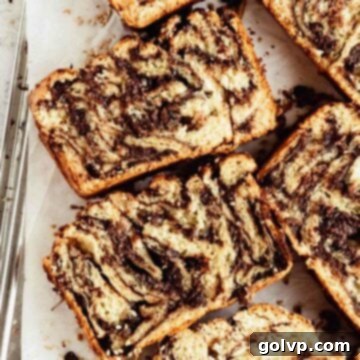
Chocolate Tahini Babka
Mary
Pin Recipe
Shop Ingredients
Equipment
-
9″ by 5″ loaf pan
Ingredients
Filling
- ⅓ cup tahini sesame butter (pure, not dressing)
- ¼ cup unsalted butter (very soft)
- ⅓ cup good quality dark chocolate, chopped (50g, use a bar for best flavor)
- 2 tablespoon natural cocoa powder sifted (for smooth filling)
- ¼ cup powdered sugar
- 1 teaspoon pure vanilla extract
- ⅛ teaspoon sea salt
- ¼ cup mini chocolate chips (for extra gooeyness)
Dough
- ¼ cup water (warm, 40-45°C / 105-115°F)
- ½ teaspoon granulated sugar (for yeast activation)
- 4 g active dry yeast (approx. ½ package or 1.25 tsp)
- 2 ½ cups all purpose flour (300g, spooned & leveled)
- ¼ cup granulated sugar
- ½ cup unsalted butter (very soft, almost melted)
- 1 large egg (beaten)
- 1 teaspoon pure vanilla extract
- ⅓ cup milk (warm)
- ⅛ teaspoon sea salt
Eggwash
- 1 large egg
- 1 tablespoon milk
- 1 teaspoon sesame seeds
- Flaky salt optional, for garnish
Shop Ingredients on Jupiter
Instructions
Filling
-
In a small saucepan, combine the tahini, unsalted butter, chopped dark chocolate, cocoa powder, powdered sugar, vanilla extract, and sea salt (all filling ingredients except for the chocolate chips). Stir over low heat until the mixture is completely smooth and melted. Remove from heat and let cool to room temperature before using.⅓ cup tahini, ¼ cup unsalted butter, ⅓ cup good quality dark chocolate, chopped, 2 tablespoon natural cocoa powder, ¼ cup powdered sugar, 1 teaspoon pure vanilla extract, ⅛ teaspoon sea salt
Dough
-
In a small bowl, dissolve the yeast and ½ tsp granulated sugar in ¼ cup warm water. Stir until dissolved, then let sit for 5-10 minutes until a foam begins to form on top. This confirms the yeast is active. If no foam forms, your yeast is likely inactive, and you should start with new yeast (see notes for troubleshooting).¼ cup water, ½ teaspoon granulated sugar, 4 g active dry yeast
-
In a large bowl, sift the 2 ½ cups all-purpose flour and make a well in the center. Add the yeast mixture and the remaining dough ingredients (¼ cup granulated sugar, ½ cup very soft unsalted butter, 1 large beaten egg, 1 tsp pure vanilla extract, ⅓ cup warm milk, ⅛ tsp sea salt) into the well. Mix with a sturdy spoon or spatula until a very sticky dough forms and all flour is incorporated. The dough will be quite wet; only add more flour if it’s excessively liquidy like thin batter, adding a tablespoon at a time. It will become less sticky after rising.2 ½ cups all purpose flour, ¼ cup granulated sugar, ½ cup unsalted butter, 1 large egg, 1 teaspoon pure vanilla extract, ⅓ cup milk, ⅛ teaspoon sea salt
-
Cover the bowl with a damp cloth or plastic wrap and place it in a warm area to rise for about 30 minutes, or until doubled in size. See notes for ideal rising conditions.
-
Prepare a 9″ x 5″ loaf pan by lining it with parchment paper, leaving two “handles” of parchment paper extending over the long sides to easily lift the babka out after baking.
-
Gently punch down the risen dough to release air, then fold it a few times in the bowl. On a lightly floured surface, roll the dough out into a rectangle approximately 18” by 23” in size. Spread the cooled chocolate sesame filling evenly over the dough, leaving a small border free. Sprinkle the ¼ cup mini chocolate chips over the filling. Starting from a short side, carefully roll the dough into a tight log.¼ cup mini chocolate chips
-
Cut the dough log in half crosswise to create two shorter logs. Then, cut each of these two shorter logs in half lengthwise to reveal the beautiful filling layers. With the filling facing up, braid the four strands together, twisting and weaving them to create the classic babka pattern. Alternatively, you can twist two strands together, twist the other two strands together, and then twist those two larger twists together for a simpler “mega twist” pattern.
-
Carefully lift the braided babka into the prepared loaf pan. Cover the pan loosely with a damp cloth or plastic wrap and let it rise in a warm place (as described in notes/tips) for another 30 minutes, or until it increases by about a third of its size.
-
Prepare the egg wash by whisking together 1 large egg and 1 tablespoon of milk. Gently brush this mixture over the top and exposed sides of the risen babka loaf. Sprinkle evenly with sesame seeds and, optionally, a pinch of flaky salt for added texture and flavor.1 large egg, 1 tablespoon milk, 1 teaspoon sesame seeds, Flaky salt
-
Place the babka into a cold oven, then immediately set the oven to preheat to 180°C (350°F). Bake for 30 – 40 minutes, or until the babka is golden brown and sounds hollow when tapped gently on the bottom. If the top starts to brown too quickly, lightly tent it with aluminum foil. Let the babka cool in the pan until it’s warm, then use the parchment handles to lift it out and transfer it to a wire rack to cool completely to room temperature. This full cooling allows the chocolate filling to set properly for perfect slices.
Video
Notes
For optimal rising, I recommend creating a warm environment in your oven. Preheat your oven to its lowest setting (around 180°C / 350°F) for just 3 minutes, then immediately turn it off. This will create a warm, cozy space for your dough to rise without getting too hot. This enriched dough, with its butter and sugar, needs consistent warmth to activate the yeast effectively. Crucially, ensure the oven doesn’t get too hot (never above 55°C / 130°F), as temperatures exceeding this will kill the yeast cells and prevent any rise.
Alternative fillings:
If you’re short on time or prefer a simpler approach, you can easily substitute the homemade filling with ⅓ cup of your favorite store-bought chocolate spread, chocolate-tahini butter, or even Nutella. Many excellent brands are available that will work wonderfully and still deliver a delicious, gooey babka experience. Simply ensure the spread is at a soft, spreadable consistency before applying it to the dough.
